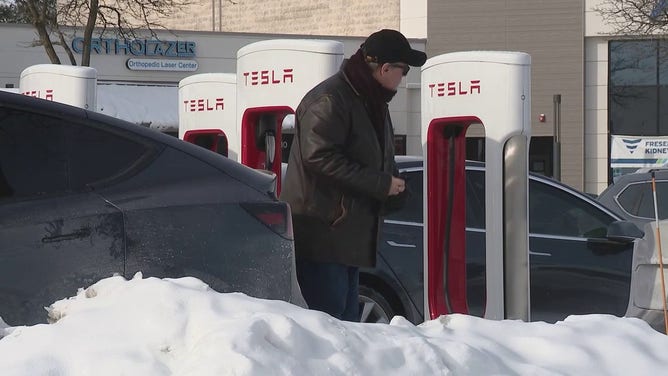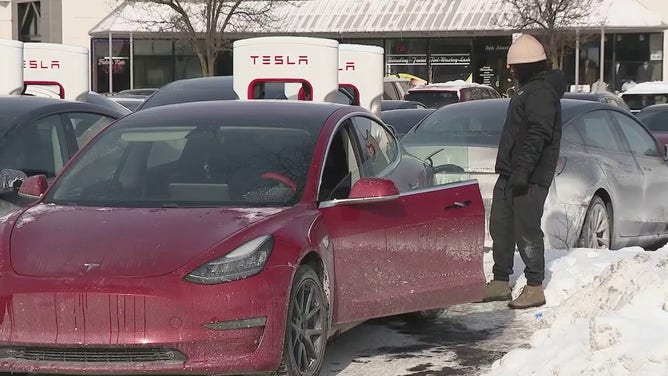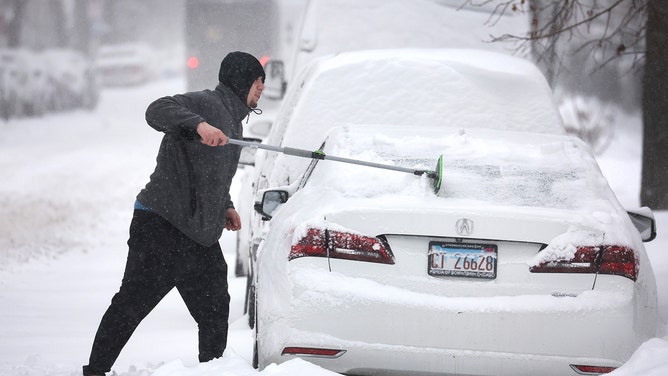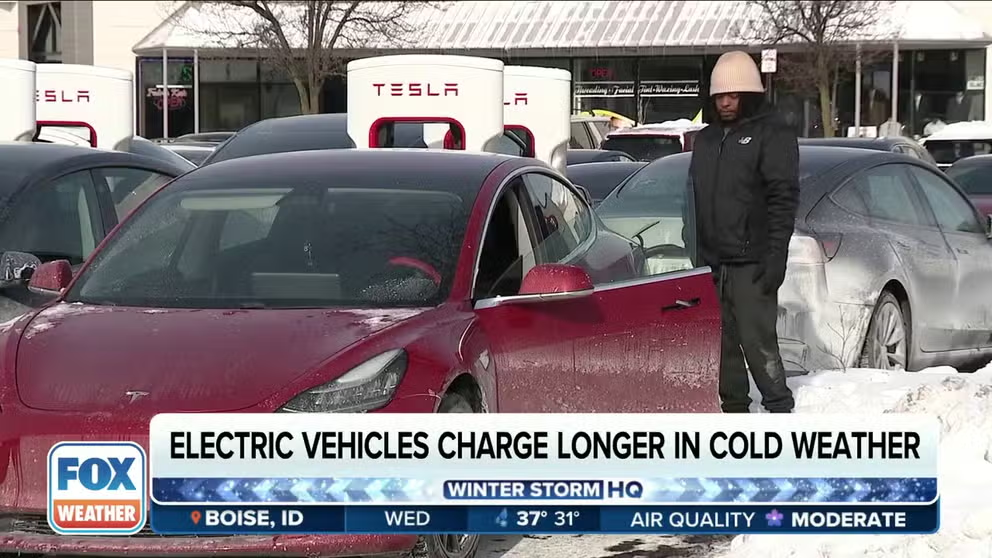Electric vehicle owners suffering reduced range, slow charging from arctic blast
Electric vehicles are programed to charge slower when the battery is too cold to avoid damaging it. The cold also saps range.
Arctic blast makes for excruciatingly slow electric vehicle charging
FOX Business Kelly Saberi reports from a frigid Illinois where electric vehicle owners are having a tough time charging during this arctic blast.
OAK BROOK, Ill. – As if the winter weather wasn't tough enough to drive through, now some electric vehicles aren't charging enough during this polar blast.
"I was at 50% (charge) when I got here. Usually from 50% to like 80-90% (it will) take like 10, 15 minutes," an angry driver told FOX Business Correspondent Kelly Saberi at an electric vehicle charging station in a Chicago suburb with 40 waiting cars. "It's taking an hour and 20 minutes."
And that is if the charger works, according to the EV owners.
"Nothing, no juice. It's still on 0%, and this is like three hours this morning," another angry driver told FOX 32 Chicago at a Tesla supercharging station. "Being out here after being out eight hours yesterday. Has it been charging? No, not at all. It just isn't working at all."
ARE ELECTRIC CARS RELIABLE IN WINTER?

A Tesla supercharging station.
(FOX 32 Chicago)
Why is my car charging so slowly in the cold?
It may not be the charger though. Electric vehicles actually slow the charging rate in extreme temperatures to avoid damaging the batteries, reported research by the Idaho National Laboratory. After a 30-minute charge at a DC Fast Charger, a battery took up to 36% less charge at 32 degrees compared to 77 degrees.
Charging deteriorates at 40 degrees, according to Electrify America.
"To ensure maximum driving range and battery safety, the Battery charge rate is decreased when the Battery is too cold, the Battery’s charge is nearly full, and when the Battery conditions change with usage and age," states the Tesla Model S owner's manual.
An EV will also use the incoming charge to heat itself to a safe temperature before charging the battery. KBB.com listed charging times in extreme cold depending on the type of charger:
- Level 1 - Most of the energy will go to heating the battery on an overnight charge.
- Level 2 - "If your car has been powered off and sitting for a prolonged period, a Level 2 charger will charge more slowly at first. Once the battery is warm enough, the charging times will pick up and level off. This rate will vary based on the external temperature and how long the vehicle has been sitting idle in the cold."
- Level 3 - Usually, a fast charger can charge a battery from 20% to 80% in 20 to 30 minutes, but in extremely cold conditions, it could take an hour.
7 THINGS YOU NEED TO KNOW TO KEEP YOUR ELECTRIC VEHICLE CRUISING THROUGH WINTER

A Tesla at a supercharging station.
(FOX 32 Chicago)
EVs lose range in extreme cold
The chemical reactions in the battery are also slower in the cold, which means less range. A battery will use its own charge to warm itself before powering a car. Plus, the same battery power goes into warming the car's cockpit.
Consumer Reports found that the range starts decreasing at 40 degrees.
AAA research shows that below 20 degrees, an electric vehicle loses 41% of its range. That means, for the same charge, a car will only go 59 miles instead of the usual 100.
Consumer Reports research shows the cold decreased range by about 25% to 31% when cruising at 70 mph compared to the same trip on a 60 to 80-degree day. Short trips with frequent stops can knock out 50% of the range.
"I have to charge multiple times every day the last couple days," a driver told Sabieri. I had to wait for like 45 minutes for a charger and then I pull in. It doesn't work, and then I pull out and then someone else takes the next charger. And then I had to wait again. So it's frustrating."
TRAVELING THIS WINTER? HERE'S WHAT TO KEEP IN YOUR CAR IN CASE YOU GET STUCK

A man clears snow from his car on February 02, 2022, in Chicago, Illinois.
(Scott Olson / Getty Images)
How to extend your range and charge in extreme cold
AAA and Electrify America have tips to extend your range and improve charging in the cold.
- Use heated seats and steering wheels to heat passengers instead of the heat system
- Leave your car on while it is plugged in and charging, which reduces the demand on the battery to heat the cabin
- Use the "preconditioning" function to warm the battery before you need to drive to make the batteries more efficient
- Plan charges and plan for more time per charge when the temperatures are cold
- Park indoors to help the battery stay warmer and hold a charge longer
